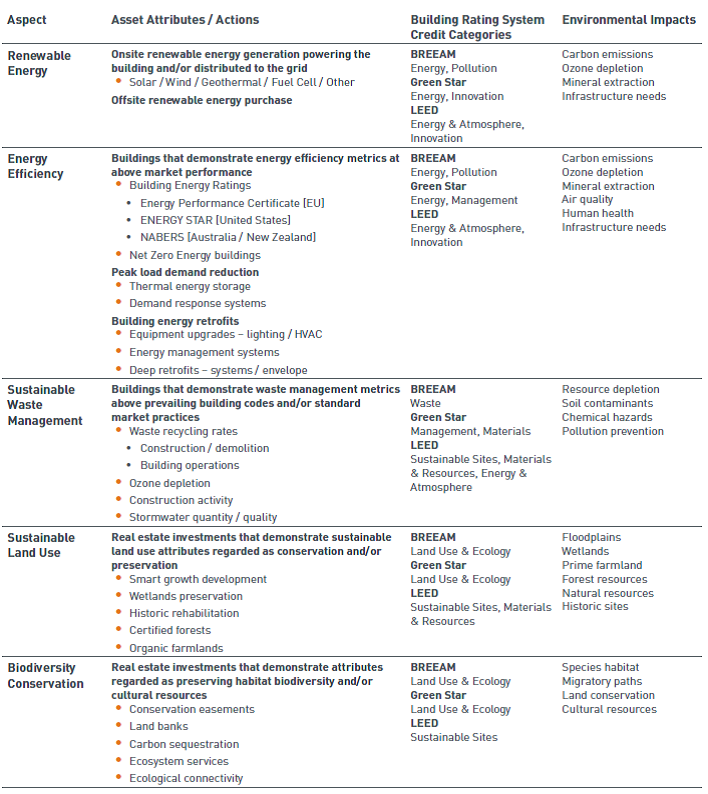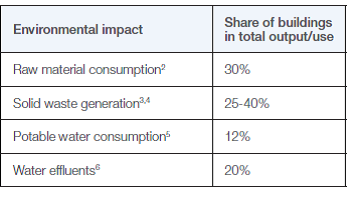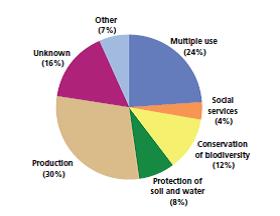New solutions for the construction industry have arisen from ambitious goals that seek to reduce the building environmental impact. New technologies using renewable materials like wood are increasingly being deployed across the sector. Nowadays, this trend is global and this sustainability transformation is also an economical evolution as building with wood also enables the development of new industries using short supply cycles.
Patrick Molinie, Business Development Manager, Technological Institute FCBA
Transforming Real Estate Development
Various sectors have already channelled significant capital towards green projects in recent years. The real estate sector in particular has a well-established track record of addressing the long term environmental challenges, from energy transition to waste and sustainable water management. The emergence of Green Building certifications has further accelerated these dynamics. A Paris climate agreement action framework has been designed to help the industry review its existing benchmark, to identify key drivers and to integrate the Environmental, Social & Governance (ESG) risks into emerging business models.An increasing awareness of the need for change in the real estate sector to meet the demand for sustainability has strengthened the already established understanding that both green technologies and energy efficiency can form an integrated approach to a healthier urban environment. In addition to this, the human-centered approach to real estate around the belief that an increasing quality of life can enhance community engagement and improve productivity has changed its entire business model.
An Ecosystem Ripe for Change
As global attitudes have changed, the ideas behind sustainability have become ever more important, alongside other trends like digitalisation and the Internet of Things (IoT). Like others, the real estate industry is embracing these new concepts in order to adapt to the changing environment.The Paris Agreement has emphasised the readiness and the commitment of the global community to work together in order to address the existing climate risks through increasing transparency and accountability, while embedding sustainability at the heart of business strategies. The ensuing evolutions in global dynamics as well as regulations and self-regulating initiatives such as the Green Bond Principles for green finance, have consolidated various sectors around the common challenges of the climate change.

From residential real estate to commercial and industrial real estate, the constant interaction with governments, industry and civil society means there are a large number of players involved in influencing standards and regulation. To give an example, the multiple environmental and social performance measurements, as well as the comprehensive documentation pertaining to them, defined the main green building rating systems such as HQE, LEED, BREEAM, Green Star, DGNB, CASBEE and others.
While Green Building Certification scorecards reveal some key environmental attributes and quantitative performance achievements of the industry, the real estate sector has also been driven by a demand for explicit qualitative sustainable assessments complementing the quantitative KPIs-based reporting standards.
Elegibility criteria for green property project
GRESB Green Bond Guidelines for the Real Estate Sector

Primary indicators
GRESB Green Bond Guidelines for the Real Estate Sector

Sustainability Becomes a Core Trend
A solid research base (often linked to specific case studies) analysing the economic outcomes of green building has dominated the real estate industry for the last few years, sparking extensive debates. As investors have paid ever more attention to ESG criteria in their selection of assets, investments principles in the construction industry have evolved. In particular, business practices have unearthed clear requirements for energy consumption, environmental protection, contribution for regional economies and communities, and social responsibility, linking all parties from owners to developers, from tenants to builders. This forward-thinking trend aimed at creating more value for future generations and was soon adopted by planners, practitioners and real estate professionals alike. Tenants have been shown to be willing to pay higher rents for energy efficient properties, as highlighted in the Global Future Council on Cities and Urbanization of the World Economic Forum [Source: World Economic Forum Industry Agenda, 2016]. This has been supported by the ground-breaking pilot study performed by the U.S. Department of Energy (DOE), which aimed at measuring the financial benefits of sustainable/green investing and identifying potential correlations between a building’s green status and its performance metrics, e.g. market value, net operating income (NOI), operating expenses, rental income, rental concessions, and occupancy [Source: U.S. Department of Energy, 2016].Sustainable real estate practices, such as use of reclaimed materials, have recently gained popularity while reducing the amount of waste that ends up in landfills. In this regard, one of the objectives of the Waste Framework Directive (2008/98/EC) is to provide a structure for moving towards a European circular economy with a high level of resource efficiency.
In connection with the obligation set by the European Union of recycling more than 70% (by weight) of non-hazardous construction and demolition waste before 2020, contractors are gradually trying to adapt and report on the matter
Guillaume Tournier, Construction Engineer, RISK Anticipation – Industry Research (EIS) at BNP Paribas
Construction and demolition waste (CDW), one of the heaviest and most voluminous waste streams generated in the EU, arises from activities such as the construction of buildings and civil infrastructure, total or partial demolition of buildings and civil infrastructure, and road planning and maintenance (very different definitions are applied throughout the EU). Despite its potential, the level of recycling and material recovery of CDW varies greatly (between less than 10% and over 90%) across the EU.
Nevertheless, examples of homes built almost exclusively out of recycled materials are multiplying across the globe. Reclaimed wood in particular represents a good way to reduce the waste, in addition to giving to your home a distinctive character while also considering our own health and wellbeing.
Wood and its derivative products have been used in construction for thousands of years in all geographical locations. For example, wooden buildings are strongly associated with Sweden’s cultural heritage (Sweden’s oldest preserved wooden buildings go back to XIII century). Building with wood has indeed a very long tradition, not only in Scandinavia but also in Japan and across Asia. Nowadays wood is widely used in construction in Germany, France, and the United States among others. A number of initiatives, including WoodRise Congress organised in Bordeaux by multiple stakeholders – the French Institute of Technology for Forest-based and Furniture Sectors (FCBA), FPInnovations Canada and the Building Research Institute of Japan – have becoming the main gatherings for prominent actors in the sustainable real estate sector. The growing popularity of wood is linked to multiple factors. Besides meeting every fire safety (most contractors use Cross-Laminated Timber (CLT) that is prefabricated to make highly durable, long-lasting wood panels that exhibit excellent fire resistance) as well as seismic code, wood offers life benefits to occupiers, such as thermal resistance. Moreover, wood is naturally renewable, reduces waste and allows for quicker and quieter deployment on site as well as easier disassembly and recyclability.
Is Wood as Energy Efficient as It Seems?
Using wood in construction is therefore indeed a big step towards transforming the industry to make it more sustainable. However, some reservations need to be taken into consideration.
Another important concern relates to the significant amount of energy necessary to dry and process wood in order to render it usable in construction. However, an informed comparison should also take into consideration both the extraction and processing involved when manufacturing other construction materials, often requiring large quantities of energy from fossil fuels. To take an example, the manufacture of cement and steel generates substantial carbon emissions and, therefore, has a positive carbon footprint. In contrast, wood is a low carbon resource: carbon dioxide is stored in wood while the emissions cause by harvesting, transportation and processing are relatively small compared to the quantity of stored carbon dioxide.

The Pioneers of a New Brave World
Recent developments have highlighted how real estate actors are adopting more responsible attitudes to environmental concerns. They go beyond the scope of environmental certification and pay greater attention to minimising their environmental footprint.The example of Artelia and other actors in the sector, like Alto, GreenAffair or Lesommer Environnment, is interesting in that regard. Artelia’s Sustainable Buildings department’s activities bring together prominent specialists in environmental performance and energy efficiency to deliver efficient construction methodologies with the lowest possible carbon footprint. Man-made climate change and a soaring world population are amongst the most challenging issues of our time. Construction of energy-efficient housing with minimum residual effect on the environment should therefore become a global priority. Building with wood that stores and absorbs, rather than emits, carbon is not just fashion; it is a necessity. In addition to this, re-forestation helps mitigate the impact of climate change in and around urban areas – in particular by cooling the air, removing harmful pollutants and fine particulates, reducing noise pollution as they shield homes from nearby roads and industrial areas, filtering water, preventing flooding by storing water in their branches and soil, helping to maintain and increase biodiversity, and creating jobs.

Future Proofing the Industry
Today the real estate sector is experiencing a remarkable transformation. The industry players broadly recognise their commitments and responsibilities in addressing the risks brought by climate change, through there viewing their investment programmes, benchmarking existing practices and taking into account the wellness of the individual to provide a more sustainable living environment.The global trends are clear: 80% of the world population will be living in cities by 2050, at which time the global population will have grown tremendously. This trend will bring clear challenges for sustainability, including ability to provide decent housing to all while at the same time transforming the real estate industry to adapt to sustainability requirements and adapting to new societal trends.
The industry is in motion and is starting to see the emergence of sustainable champions that will gain enhanced traction in the coming decades. However, the industry must not be complacent. Even in emerging fields, innovation can arise and accelerate the disruption. In the field of real estate, issues related to 3D printing, for example, are poised to become more prevalent, with automated, robot-based, house building expected to become reality at some point in the next few decades.
Similarly, issues related to new societal organisation trends leveraging new transportation methods (e.g. Hyperloop or automated driving), population ageing, or remote working, are likely to become new forces impacting the industry at large.
Conclusion
In spite of the conundrums affecting the industry and the intricate complexities that are common in such interconnected economies and societies, wood seems to be on track to become one of the winners of the switch to sustainability in the real estate industry.As consumers increasingly turn their backs on more natural consumption habits, and as sustainability re-enters people’s lives after decades of systematic excess use of the world’s natural resources, new initiatives are bringing back wood to the frontline of the construction industry: it is the consummate construction material, used for thousands of years. In this way it is beginning to re-enter homeowners’ collective consciousness.
Forty years after the concrete-based 50-60-70’s architecture, construction is coming back to its natural roots, and finally aligning to society’s demand for more sustainability.